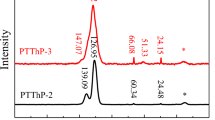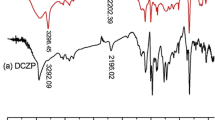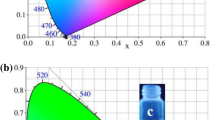Abstract
Two kinds of fluorescent conjugated microporous polymers containing pyrazine moieties were prepared by the polymerization reaction of 2,5-di-triphenylamine-yl-pyrazine (DTPAPz) and N,N,N′,N′-tetrapheny-2,5-(diazyl) pyrazine (TDPz) with 2,4,6-trichloro-1,3,5-triazine (TCT) through Friedel–Crafts reaction using the methanesulfonic acid as a catalysts. Both CMPs have high thermal stability and decomposition temperature reaches above 596 and 248 °C under nitrogen atmosphere, respectively. By right of porous morphology and electron-donating nitrogen, as well as electron-rich π-conjugated structures, the adsorption performance for iodine vapor on the CMPs is very excellent, which can reach 441% and 312%. In addition, fluorescence studies showed that the two CMPs exhibited high fluorescence sensitivity to electron-deficient iodine, o-nitrophenol (o-NP), and picric acid (PA) via fluorescence quenching.









Similar content being viewed by others
References
A SG, Zhang YW, Li ZP, Xia H, Xue M, Liu XM, Mu Y (2014) Highly efficient and reversible iodine capture using a metalloporphyrin-based conjugated microporous polymer. Chem Commun 50:8495–8498
Abdelmoaty YH, Tessema TD, Choudhury FA, El-Kadri OM, El-Kaderi HM (2018) N-rich porous polymers for carbon dioxide and iodine sequestration for environmental remediation. ACS Appl Mater Interfaces 10:16049–16058
Bhunia S, Chatterjee N, Das S, Saha KD, Bhaumik A (2014) Porous polyurea network showing aggregation induced white light emission, applications as biosensor and scaffold for drugdelivery. ACS Appl Mater Interfaces 6:22569–22576
Cao XL, Li X, Liu FX, Luo YN, Yu LY (2018) Copper nanoclusters as fluorescence-quenching probes for the quantitative analysis of total iodine. Luminescence 33(5):981–985
Chen DY, Fu Y, Yu WG, Yu GP, Pan CY (2018) Versatile adamantane-based porous polymers with enhanced microporosity for efficient CO2 capture and iodine removal. Chem Eng J 334:900–906
Chen YF, Sun HX, Yang RX, Wang TT, Pei CJ, Xiang ZT, Zhu ZQ, Liang WD, Li A, Deng WQ (2015) Synthesis of conjugated microporous polymer nanotubes with large surface areas as absorbents for iodine and CO2 uptake. J Mater Chem A 3:87–91
Chen Z, Chen M, Yu YL, Wu LM (2017) Robust synthesis of free-standing and thickness controllable conjugated microporous polymer nanofilms. Chem Commun 53:1989–1992
Comotti A, Bracco S, Ben T, Qiu SL, Sozzani PM (2014) Rotors in porous organic frameworks. Angew Chem Int Ed 53:1043–1047
Dang QQ, Wang XM, Zhan YF, Zhang XM (2016) An azo-linked porous triptycene network as an absorbent for CO2 and iodine uptake. Polym Chem 7:643–647
Das G, Prakasam T, Nuryyeva S, Han DS, Abdel-Wahab A, Olsen JC, Polychronopoulou K, Platas-Iglesias C, Ravaux F, Jouiad M (2016) Multifunctional redox-tuned viologen-based covalent organic polymers. J Mater Chem A 4:15361–15369
Das G, Skorjanc T, Sharma SK, Gndara F, Lusi M, Rao DSS, Vimala S, Prasad SK, Raya J, Han DS, Jagannathan R, Olsen JC, Trabolsi A (2017) Viologen-based conjugated covalent organic networks via Zincke reaction. J Am Chem Soc 139:9558–9565
Deshmukh A, Bandyopadhyay S, James A, Patra A (2016) Trace level detection of nitroanilines using a solution processable fluorescent porous organic polymer. J Mater Chem C 4:4427–4433
Dey S, Bhunia A, Janiak DEC (2016) Covalent triazine-based frameworks (CTFs) from triptycene and fluorene motifs for CO2 adsorption. J Mater Chem A 4:6259–6263
Ding SY, Dong M, Wang YW, Chen YT, Wang HZ, Su CY, Wang W (2016) Thioether-based fluorescent covalent organic framework for selective detection and facile removal of mercury(II). J Am Chem Soc 138:3031–3037
Geng TM, Chen GF, Xia HY, Zhang WY, Zhu ZM, Cheng BS (2018a) Poly{tris[4-(2-thienyl)phenyl]amine} and poly[tris(4-carbazoyl-9-yl phenyl)amine] conjugated microporous polymers as absorbents for highly efficient iodine adsorption. J Solid State Chem 265:85–91
Geng TM, Ye SN, Zhu ZM, Zhang WY (2018b) Triazine-based conjugated microporous polymers with N,N,N′,N′-tetraphenyl-1,4-phenylenediamine, 1,3,5-tris(diphenylamino)benzene and 1,3,5-tris[(3-methylphenyl)- phenylamino]benzene as the core for high iodine capture and fluorescence sensing of o-nitrophenol. J Mater Chem A 6:2808–2816
Geng TM, Zhang WY, Zhu ZM, Kai XM (2019) Triazine-based conjugated microporous polymers constructing triphenylamine and its derivatives with nitrogen as core for iodine adsorption and fluorescence sensing I2. Microporous Mesoporous Mater 273:163–170
Geng TM, Zhu ZM, Zhang WY, Wang Y (2017) A nitrogen-rich fluorescent conjugated microporous polymer with triazine and triphenylamine units for high iodine capture and nitro aromatic compound detection. J Mater Chem A 5:7612–7617
Gu C, Huang N, Gao J, Xu F, Xu YH, Jiang DL (2014) Controlled synthesis of conjugated microporous polymer films: versatile platforms for highly sensitive and label-free chemo-and biosensing. Angew Chem 126:4950–4955
Gu S, He JQ, Zhu YL, Wang ZQ, Chen DY, Yu GP, Pan CY, Guan JG, Tao K (2016) Facile carbonization of microporous organic polymers into hierarchically porous carbons targeted for effective CO2 uptake at low pressures. ACS Appl Mater Interfaces 8:18383–18392
Guo L, Cao DP (2015) Color tunable porous organic polymer luminescent probes for selective sensing of metal ions and nitroaromatic explosives. J Mater Chem C 3:8490–8494
Guo L, Cao DP, Yun J, Zeng XF (2017) Highly selective detection of picric acid from multicomponent mixtures of nitro explosives by using COP luminescent probe. Sensors Actuators B 243:753–760
Guo L, Zeng XF, Cao DP (2016) Porous covalent organic polymers as luminescent probes for highly selective sensing of Fe3+ and chloroform: functional group effects. Sensors Actuators B 226:273–278
Guo XH, Tian Y, Zhang MC, Li Y, Wen R, Li X, Li XF, Xue Y, Ma LJ, Xia CQ, Li SJ (2018) Mechanistic insight into hydrogen-bond-controlled crystallinity and adsorption property of covalent organic frameworks from flexible fuilding flocks. Chem Mater 7:2299–2308
Harijan DKL, Chandra V, Yoon T, Kim KS (2018) Radioactive iodine capture and storage from water using magnetite nanoparticles encapsulated in polypyrrole. J Hazard Mater 344:576–584
Hayashi S, Togawa Y, Yamamoto SI, Koizumi T, Nishi K, Asano A (2017) Synthesis of π-conjugated network polymers based on fluoroarene and fluorescent units via direct arylation polycondensation and their porosity and fluorescent properties. J Polym Sci A Polym Chem 55(23):3862–3867
Janeta M, Bury W, Szafert S (2018) Porous silsesquioxane−imine frameworks as highly efficient adsorbents for cooperative iodine capture. ACS Appl Mater Interfaces 10:19964–19973
Li GY, Yao C, Wang JK, Xu YH (2017) Synthesis of tunable porosity of fuorine-enriched porous organic polymer materials with excellent CO2, CH4 and iodine adsorption. Sci Rep 7:13972
Li H, Ding XS, Han BH (2016) Porous azo-bridged porphyrin–phthalocyanine network with high iodine capture capability. Chem Eur J 33:11863–11868
Li YK, Bi SM, Liu F, Wu SY, Hu J, Wang LM, Liu HL, Hu Y (2015a) Porosity-induced emission: exploring color-controllable fluorescence of porous organic polymers and their chemical sensing applications. J Mater Chem C 3:6876–6881
Li ZP, Li H, Xia H, Ding XS, Luo XL, Liu XM, Mu Y (2015b) Triarylboron-linked conjugated microporous polymers: sensing and removal of fluoride ions. Chem Eur J 21:17355–17362
Liao YZ, Cheng ZH, Zuo WW, Thomas A, Faul CFJ (2017a) Nitrogen-rich conjugated microporous polymers: facile synthesis, efficient gas storage and heterogeneous catalysis. ACS Appl Mater Interfaces 9:38390–38400
Liao YZ, Li JH, Thomas A (2017b) General route to high aurface area covalent organic frameworks and their metal oxide composites as magnetically recoverable adsorbents and for energy storage. ACS Macro Lett 6:1444–1450
Liao YZ, Weber J, Mills BJM, Ren ZH, Fau CFJ (2016) Highly efficient and reversible iodine capture in hexaphenylbenzene-based conjugated microporous polymers. Macromolecules 49:6322–6333
Lin GQ, Ding HM, Yuan DQ, Wang BS, Wang C (2016) A pyrene-based, fluorescent three-dimensional covalent organic framework. J Am Chem Soc 138:3302–3305
Lin Y, Jiang X, Kim ST, Alahakoon SB, Hou X, Zhang Z, Thompson CM, Smaldone RA, Ke C (2017) An elastic hydrogenbonded cross-linked organic framework for effective iodine capture in water. J Am Chem Soc 139:7172–7175
Liu W, Ulaganathan MN, Abdelwahab I, Luo X, Chen ZX, Tan SJR, Wang XW, Liu YP, Geng DC, Bao Y, Chen JY, Loh KP (2018) Two-dimensional polymer synthesized via solid-state polymerization for high performance supercapacitors. ACS Nano 12:852–860
Ma DX, Li BY, Cui ZH, Liu K, Chen C, Li GH, Hua J, Ma BH, Shi Z, Feng SH (2016b) Multifunctional luminescent porous organic polymer for selectively detecting iron ions and 1,4-dioxane via luminescent turn-off and turn-on sensing. ACS Appl Mater Interfaces 8:24097–24103
Ma H, Chen JJ, Tan LX, Bu JH, Zhu YY, Tan BE, Zhang C (2016) Nitrogen-rich triptycene-based porous polymer for gas storage and iodine enrichment. ACS Macro Lett 5:1039–1043
Ma HP, Li B, Zhang LM, Han D, Zhu GS (2015) Targeted synthesis of core–shell porous aromatic frameworks for selective detection of nitro aromatic explosives via fluorescence two dimensional response. J Mater Chem A 3:19346–19352
Meng LB, Zou XQ, Guo SK, Ma HP, Zhao YN, Zhu GS (2015) Self-supported fibrous porous aromatic membranes for efficient CO2/N2 separations. ACS Appl Mater Interfaces 7:15561–15569
Pei CY, Ben T, Xu SX, Qiu SL (2014) Ultrahigh iodine adsorption in porous organic frameworks. J Mater Chem A 2:7179–7187
Puthiaraj P, Cho SM, Lee YR, Ahn WS (2015) Microporous covalent triazine polymers: efficient friedel–crafts synthesis and adsorption/storage of CO2 and CH4. J Mater Chem A 3:6792–6797
Puthiaraj P, Kim S, Ahn WS (2016) Covalent triazine polymers using a cyanuric chloride precursor via Friedel–Crafts reaction for CO2 adsorption/separation. Chem Eng J 283:184–192
Qian X, Wang B, Zhu ZQ, Sun HX, Ren F, Mu P, Ma CH, Liang WD, Li A (2017) Novel N-rich porous organic polymers with extremely high uptake for capture and reversible storage of volatile iodine. J Hazard Mater 338:224–232
Qian X, Zhu ZQ, Sun HX, Ren F, Mu P, Liang WD, Chen LH, Li A (2016) Capture and reversible storage of volatile iodine by novel conjugated microporous polymers containing thiophene units. ACS Appl Mater Interfaces 8:21063–21069
Rao KV, Haldar R, Maji TK, George SJ (2016) Dynamic, conjugated microporous polymers: visible light harvesting via guest-responsive reversible swelling. Phys Chem Chem Phys 18:156–163
Ren F, Zhu ZQ, Qian X, Liang WD, Mu P, Sun HX, Liu JH, Li A (2016) Novel thiophene-bearing conjugated microporous polymer honeycomb-like porous spheres with ultrahigh iodine uptake. Chem Commun 52:9797–9800
Ren YY, Zhang WY, Zhu YL, Wang DG, Yu GP, Kuang GC (2018) Nitrogen-rich porous polyaminal network as a platform for iodine adsorption through physical and chemical interaction. J Appl Polym Sci 15:46106
Shetty D, Raya J, Han DS, Asfari ZH, Olsen JC, Trabolsi A (2017) Lithiated polycalix[4]arenes for efficient adsorption of iodine from solution and vapor phases. Chem Mater 29:8968–8972
Skorjanc T, Shetty D, Sharma SK, Raya J, Traboulsi H, Han DS, Lalla J, Newlon R, Jagannathan R, Kirmizialtin S, Olsen JC, Trabolsi A (2018) Redox-responsive covalent organic nanosheets from viologens and calix[4]arene for iodine and toxic dye capture. Chem Eur J 34:8648–8655
Sun HX, Yang BL, Li A (2019) Biomass derived porous carbon for efficient capture of carbon dioxide, organic contaminants and volatile iodine with exceptionally high uptake. Chem Eng J 372:65–73
Suresh VM, Bandyopadhyay A, Roy S, Pati SK (2015) Maji TK, Highly luminescent microporous organic polymer with lewis acidic boron sites on the pore surface: ratiometric sensing and capture of F- ions. Chem Eur J 21:10799–10804
Troschke E, Gratz S, Lubken T, Borchardt L (2017) Mechanochemical friedel–crafts alkylation−a sustainable pathway towards porous organic polymers. Angew Chem Int Ed 24:129 6963–129 6967
Wang C, Wang Y, Ge RL, Song XD, Xing XQ, Jiang QK, Lu H, Hao C, Guo XW, Gao YN, Jiang DL (2018a) A 3D covalent organic framework with exceptionally high iodine capture capability. Chem Eur J 24:585–589
Wang DX, Feng SY, Liu HZ (2016a) Fluorescence-tuned polyhedral oligomeric silsesquioxane-based porous polymers. Chem Eur J 22:14319–14327
Weng JY, Xu YL, Song WC, Zhang YH (2016) Tuning the adsorption and fluorescence properties of aminal-linked porous organic polymers through N- heterocyclic group decoration. J Polym Sci Part A: Polym Chem 54:1724–1730
Wang P, Xu Q, Li ZP, Jiang WM, Jiang QH, Jiang DL (2018b) Exceptional iodine capture in 2D covalent organic frameworks. Adv Mater 29:1801991
Wang S, Liu YC, Ye Y, Meng XY, Du JF, Song XW, Liang ZQ (2019) Ultrahigh volatile iodine capture by conjugated microporous polymer based on N,N,N',N'-tetraphenyl-1,4-phenylenediamine. Polym Chem 10(20):2608–2615
Wang XY, Zhang C, Zhao Y, Ren SJ, Jiang JX (2016b) Synthetic control and multifunctional properties of fluorescent covalent triazine based frameworks. Macromol Rapid Commun 37:323–329
Wu XF, Li HB, Xu YX, Tong H, Wang LX (2015) Intramolecular charge-transfer emission from conjugated polymer nanoparticles: the terminal group effect on electronic and optical properties. Polym Chem 6:2305–2311
Wu WB, Ye SH, Yu G, Liu YQ, Qin JG, Li Z (2012) Novel functional conjugative hyperbranched polymers with aggregation-induced emission: synthesis through one-pot “A2+B4” polymerization and application as explosive chemsensors and PLEDs. Macromol Rapid Commun 33:164–171
Xiang L, Zhu YL, Gu S, Chen DY, Fu X, Zhang YD, Yu GP, Pan CY, Hu YH (2015) A luminescent hypercrosslinked conjugated microporous polymer for efficient removal and detection of mercury ions. Macromol Rapid Commun 36:1566–1571
Xie W, Cui D, Zhang SR, Xu YH, Jiang DL (2019) Iodine capture in porous organic polymers and metal-organic frameworks materials. Mater Horiz. https://doi.org/10.1039/c8mh01656a
Xiong SH, Fu X, Xiang L, Yu GP, Guan JG, Wang ZG, Du Y, Xiong X, Pan CY (2014) Liquid acid-catalysed fabrication of nanoporous 1,3,5-triazine frameworks with efficient and selective CO2 uptake. Polym Chem 5:3424–3431
Yamamoto T, Fujiwara Fukumoto YH, Nakamura Y, Koshihara SY, Ishikawa T (2003) Preparation of a new poly(p-phenylene) type polymer, poly(pyrazine-2,5-diyl), with a coplanar structure. Polymer 44:4487–4490
Yan ZJ, Yuan Y, Tian YY, Zhang DM, Zhu GS (2015) Highly efficient enrichment of volatile iodine by charged porous aromatic frameworks with three sorption sites. Angew Chem Int Ed 54:12733–12737
Yao C, Li GY, Wang JK, Xu YH, Chang LM (2018) Template-free synthesis of porous carbon from triazine based polymers and their use in iodine adsorption and CO2 capture. Sci Rep 8:1867
Yin ZJ, Xu SQ, Zhan TG, Qi QY, Wu ZQ, Zhao X (2017) Ultrahigh volatile iodine uptake by hollow microspheres formed from a heteropore covalent organic framework. Chem Commun 53:7266–7269
Yuan K, Wang PYG, Hu T, Shi L, Zeng R, Forster M, Pichler T, Chen YW, Scherf U (2015) Nanofibrous and graphene-templated conjugated microporous polymer materials for flexible chemosensors and supercapacitors. Chem Mater 27:7403–7411
Zang JK, Zhu ZQ, Mu P, Sun HX, Liang WD, Yu FC, Chen LH, Li A (2016) Synthesis and properties of conjugated microporous polymers bearing pyrazine moieties with macroscopically porous 3D networks structures. Macromol Mater Eng 301:1104–1110
Zhang CY, Tour JM (1999) Synthesis of highly functionalized pyrazines by ortho-lithiation reactions. pyrazine ladder polymers. J Am Chem Soc 38:8783–8790
Zhang P, Guo J, Wang CC (2012a) Magnetic CMP microspheres: multifunctional poly(phenylene ethynylene) frameworks with covalently built-in Fe3O4 nanocrystals exhibiting pronounced sensitivity for acetaminophen microdetection. J Mater Chem 22:21426–21433
Zhang W, Qiua LG, Yuan YP, Xie AJ, Shen YH, Zhu JF (2012b) Microwave-assisted synthesis of highly fluorescent nanoparticles of a melamine-based porous covalent organic framework for trace-level detection of nitroaromatic explosives. J Hazard Mater 221–222:147–154
Zhu YL, Ji YJ, Wang DG, Zhang Y, Tang H, Jia XR, Song M, Yu GP, Kuang GC (2017) Bodipy-based conjugated porous polymers for highly efficient volatile iodine capture. J Mater Chem A 5:6622–6629
Funding
This work was supported by the Natural Science Foundation of Anhui Education Department (under Grant No. KJ2018A0319) and the open fund of AnHui Province Key Laboratory of Optoelectronic and Magnetism Functional Materials (under Grant No. ZD2017007).
Author information
Authors and Affiliations
Corresponding author
Additional information
Responsible editor: Philippe Garrigues
Publisher’s note
Springer Nature remains neutral with regard to jurisdictional claims in published maps and institutional affiliations.
Electronic supplementary material
ESM 1
(DOCX 4.97 MB)
Rights and permissions
About this article
Cite this article
Geng, T., Ma, L., Chen, G. et al. Fluorescent conjugated microporous polymers containing pyrazine moieties for adsorbing and fluorescent sensing of iodine. Environ Sci Pollut Res 27, 20235–20245 (2020). https://doi.org/10.1007/s11356-019-06534-8
Received:
Accepted:
Published:
Issue Date:
DOI: https://doi.org/10.1007/s11356-019-06534-8




